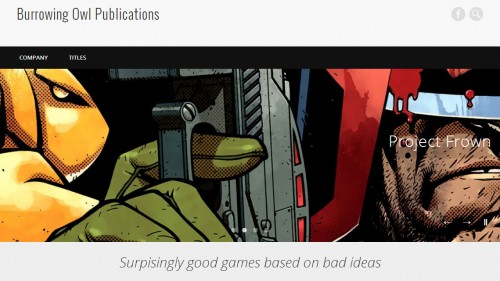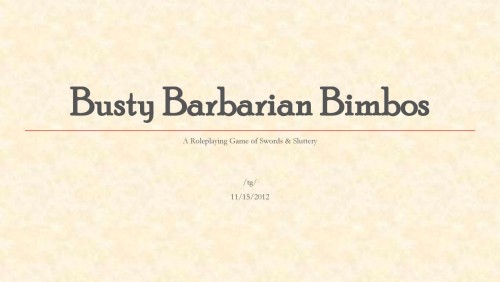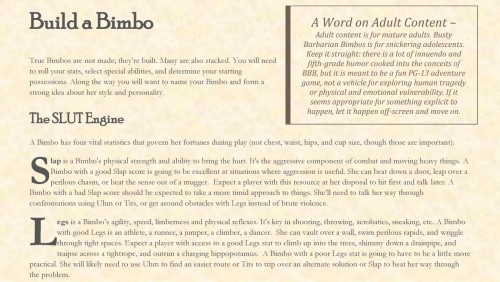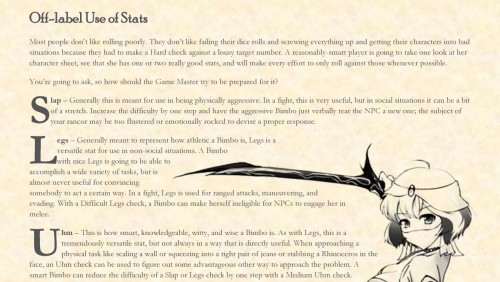With three separate game development ideas dancing around in my head lately, and one project under my belt, I’ve launched Burrowowing Owl Publications as a separate Internet entity. Enjoy responsibly.
Author Archives: Burrowowl
Busty Barbarian Bimbos
(MediaFire link [PDF])
Back in March of this year, somebody posted the following to the Traditional Games forum on 4chan:
/tg/ I have a dream!
I want to make a parody tabletop RPG in which the players take on the role of cartoonishly awesome bimbos. I have no plans other than that the attributes spell SLUT (prelimanary idea: Strong, Limber, Uhmmm, and Titties) when put together and a slight inkling that it will play rather like KAMB with a high mortality rate.
Any suggestions?
A lively discussion followed, with several ideas bounced back and forth, several of them awful but some showing a degree of promise. There was enough interest that additional threads sprung up in the following days and I started to participate in developing it on the 1d4chan.org wiki. It’s important to remember that /tg/ collectively prides itself on the sometimes-faulty premise that “/tg/ gets shit done,” so once it became apparent that Braindead Bimbo Barbarians could become something actually playable, it was incumbent upon somebody to actually develop and finish it.
That somebody turned out to be me. Between several rounds of public brainstorming on /tg/ and playtesting via IRC and my weekly D&D group, there were several month-long spells where the was no progress to be had. The basic conceit stayed the same: a lighthearted adventure game about impractically-garbed women in a world of swords & sorcery. The name changed as we went along (the protagonists aren’t necessarily stupid), and there were a fair number of flame wars regarding gender roles in gaming, but work progressed sporadically.
Earlier this month I finally bit the bullet and had to make a decision. Should I get serious about commissioning original art, wade through stock art sites for legitimately-licenced material, and go through the paces of producing a proper published book (possibly funded through Indiegogo or Kickstarter)? Or should I just dig up some found art, put together a layout, and publish it non-commercially in the the spirit of free use? I chose the latter.
And so was born the first Burrowing Owl Publications release: Busty Barbarian Bimbos
BBB features an extremely math-lite conflict resolution system. All rolls are three six-sided dice compared against a player’s own stats. Any die showing a number equal to or lower than the stat in question is a success. Hard checks require three successes. Medium check require two. Easy checks require one. Critical successes are to be had on two or more ones, critical failures on two or more sixes. There are no modifiers to character stats or to die rolls, precluding the need for addition or subtraction.
Conflict is handled based on characters’ and creatures’ attitudes towards each other. A hostile dinosaur can be calmed down or an indifferent guard made helpful or friendly. Combat is only possible when one or more of the parties are hostile, allowing most situations to be defused through a protagonist’s social skills. When things come to blows, there are no hit points (applying damage to a hit point pool is math), but a mildly innovative system by which stats can be disabled is used instead. To avoid incapacitation, heroines may risk their clothing in Wardrobe Malfunctions. Enemies benefit from Plot Armor that works similarly.
Character options are rather limited by the core conceit of the game: if you don’t want your character to be an aggressive, athletic, clever, or beautiful woman, this simply isn’t the right game for you right now. In addition to the four primary stats of Slap, Legs, Uhm, and Tits, a beginning character gets two Basic Abilities and one Advanced Ability that allow her special rules benefits or even access to spellcasting abilities. Through the Abilities system a character can mitigate the impact of her poorer stats or accentuate the advantages of her better stats.
Three methods of character creation are presented, two of which arrive at stats randomly, one of which promotes collaborative character creation among a playgroup. Collaborative character creation results in a 2/3/4/5 stat spread, while the random methods ensure that high Slap, Legs, and Uhm stats will have a negative impact on the character’s final Tits score (sorry, you don’t get to be strong, athletic, clever, and gorgeous).
Busty Barbarian Bimbos is meant primarily for single-session, low-preptime use by groups of players that are comfortable with having fun with characters and situations that would be utterly ridiculous in most mainstream roleplaying games. Please enjoy responsibly.
(MediaFire link [PDF])
With thanks to several anonymous contributors, Dan, Erik, and Julian for playtesting duty, Viral of Viral Games for setting a good example, Ryan Macklin for inadvertently scaring me away from publishing this for money, and my wife for putting up with me.
Pondering Measure Q
If there’s one item on my November ballot that has rustled my jimmies, it has to be Santa Rosa’s Measure Q. Q proposes to take the seven-member city council, traditionally elected as at-large representatives of the entire city, and divvy them up into separate districts to represent the various neighborhoods and constituencies of various parts of town. They will continue to select a mayor from among themselves, and will continue to server four-year terms.
There are two leading arguments that I have seen put forward by the “no” camp here, both in the form of newspaper articles and push-polls I’ve received at home. Quoted from yesterday’s Press Democrat:
First of all, Measure Q takes away 85 percent of your current votes for members of the City Council. This stifles your political voice, not enhances it as proponents claim.
Second, you now have the ability to vote for all seven council members. If you vote for Measure Q (district elections), you will not be able to vote for six other council members. Consequently those six will no longer be accountable to you. This undermines your influence as a citizen, not enlarges it as the proponents claim.
The stickler in me that perks up whenever numbers come into play immediately sees this as a steaming pile of bullshit. If you reduce my ability to vote for city council members from 7 members to one member, that leaves me with a little over 14% of my number of voted-for council members. So your two arguments for me are that I only get 1/7th of the power and furthermore, in addition to that, I get my voting power reduced by 85%? That’s just repeating one argument twice. This may be nit-picking, but I don’t appreciate being spoken to with those kind of patronizing smokescreen tactics when I’m entrusted with legislative responsibility over my community at the polls.
The more substantial problem with this line of reasoning is that while a resident of Santa Rosa has normally been able to vote for candidates for all seven Council positions, the 2010 census shows my vote is competing with some 167,814 other opinions. So overall I have 7/167815ths of a say in who our representatives are. Split that up into districts as proposed by Measure Q and my voting power becomes, ostensibly, 1/23973rd. No change in the prima facia potency of my ballot. Instead of 7 extremely-watered-down votes, I get one somewhat-less-watered-down vote.
To get a little more practical, in 2008 there were eleven candidates running for four open positions. In 2010 there were seven candidates running for three open positions, some of whom also ran in 2008. In 2012 there are seven candidates contending for four open positions. It’s pretty clear that we don’t have a rough time scrounging up two or more candidates for every open position under the existing system. I consider that a good thing, your mileage may vary.
Trying to stay practical, different segments of the population vote at different rates. Elderly, educated white people are more likely to vote than younger minorities with less education. There are a thousand demographic divisions one could look at, but generally speaking the portions of the population most likely to vote, and thus more likely to see their interests reflected in the City Council Elections tend to be clustered in a section of town that can be broadly describes as the north-east quarter. Most of our Council members in recent decades hail from that area. People who live in the North-west are more likely to vote than their counterparts in the less affluent South-west, and would see their voting power decreased somewhat. Meanwhile everybody else that is already in the habit of casting a ballot will see their per-capita voting power increase.
Regarding the ancillary argument that district representation would lead to intra-Council division and strife, delaying projects that are in the whole city’s interest, it seems to me this has always been the case and likely always will be. Many cities use district representatives successfully, and there is little indication that at-large representation is of any benefit at all.
As somebody who doesn’t live in a bastion of high election participation, Measure Q appears to be in my self interest.
Full text of Measure Q (PDF)




